Merlin MacAulay, Fifteen Months on Sable Island, 1955-1956
In May 1955, after completing the 16-week course at the Upper Air Training School on Centre Island, Toronto, and then serving a few months in Sept-Îles, Quebec, I went to Sable Island on the DOT ship Lady Laurier to work as an upper air technician for the Meteorological Service of Canada (MSC). I was 23 years old. I was scheduled to be there for 12 months but was asked to stay on for an extra three. So, I ended up working on the island for 15 months without a break.
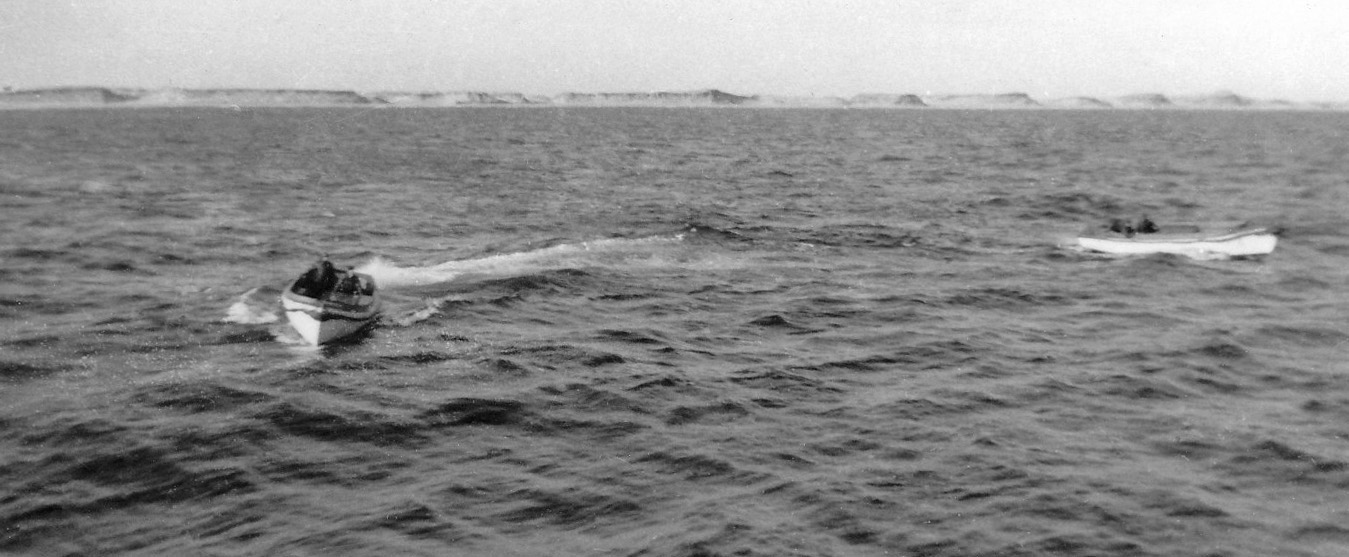 Small boats were used to move people and supplies between Sable Island and the DOT vessel Lady Laurier which was anchored off the north side of the island.
Small boats were used to move people and supplies between Sable Island and the DOT vessel Lady Laurier which was anchored off the north side of the island.
Island Residents
During my time, there were about 35 people on Sable Island: MSC staff (4) and the OIC’s family (2-3); radio operators (3) and the radio OIC’s family (3); and the island Superintendent Charles Faulkner, his housekeeper, and staffmen (~25). All three groups were part of the Department of Transport (DOT).
Ralph Newell was the OIC (Officer-in-Charge) for MSC when I arrived. Ralph was from Cape Sable Island on the Nova Scotia mainland. His wife Muriel and young son Daryl lived with him on the island. Ralph stayed on Sable for two years, his second year overlapping with me. He operated a ham radio on Sable—the ham radio call sign was VE1SD. (I once talked to my father on the ham radio—my parents were in Prince Edward Island (PEI).) When Ralph left on the summer boat in 1955, he was replaced by Max Lee. Max was from Toronto. On the island with Max were his wife Evelyn, son, and mother-in-law (who was blind).
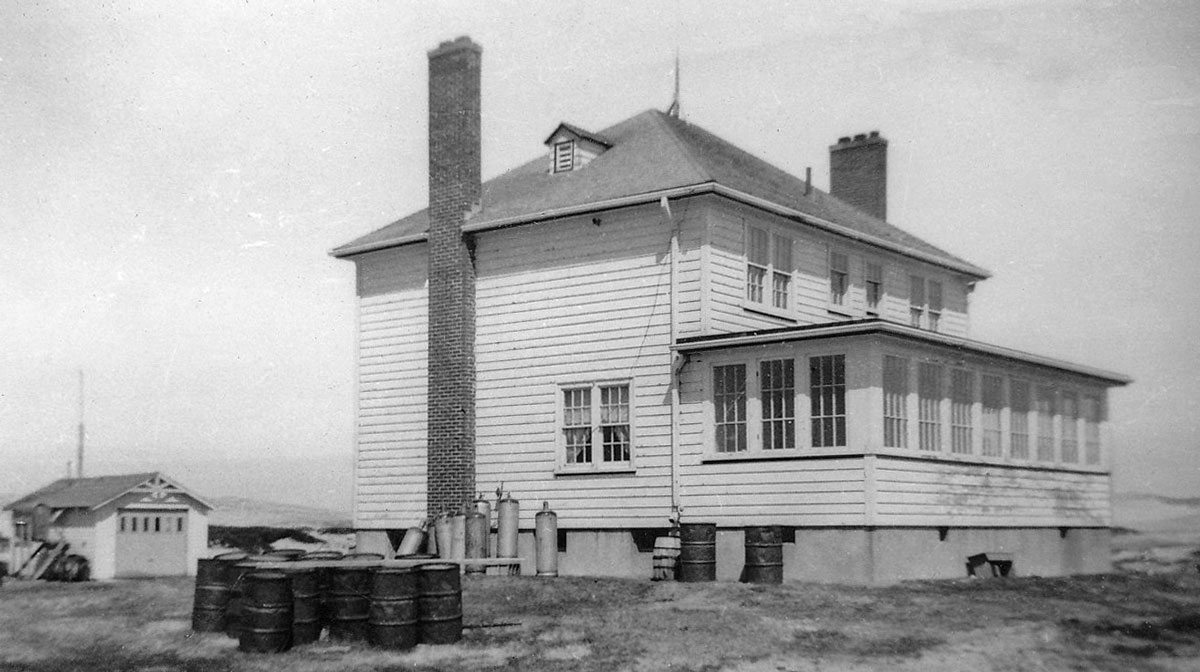 At the MSC station. In 1955-56, this was the the house of the MSC Officer-in-Charge. It later became the “staff house”.
At the MSC station. In 1955-56, this was the the house of the MSC Officer-in-Charge. It later became the “staff house”.
Other MSC staff were Gordie Miller, Bob Frank (he eventually retired in Bridgewater), and Carl Wyman. Carl left after a month. He had a wife and a couple of children in his hometown of Yarmouth, so it was difficult for him being on the island and separated from his family. Carl was replaced by Jean-Guy Pagé.
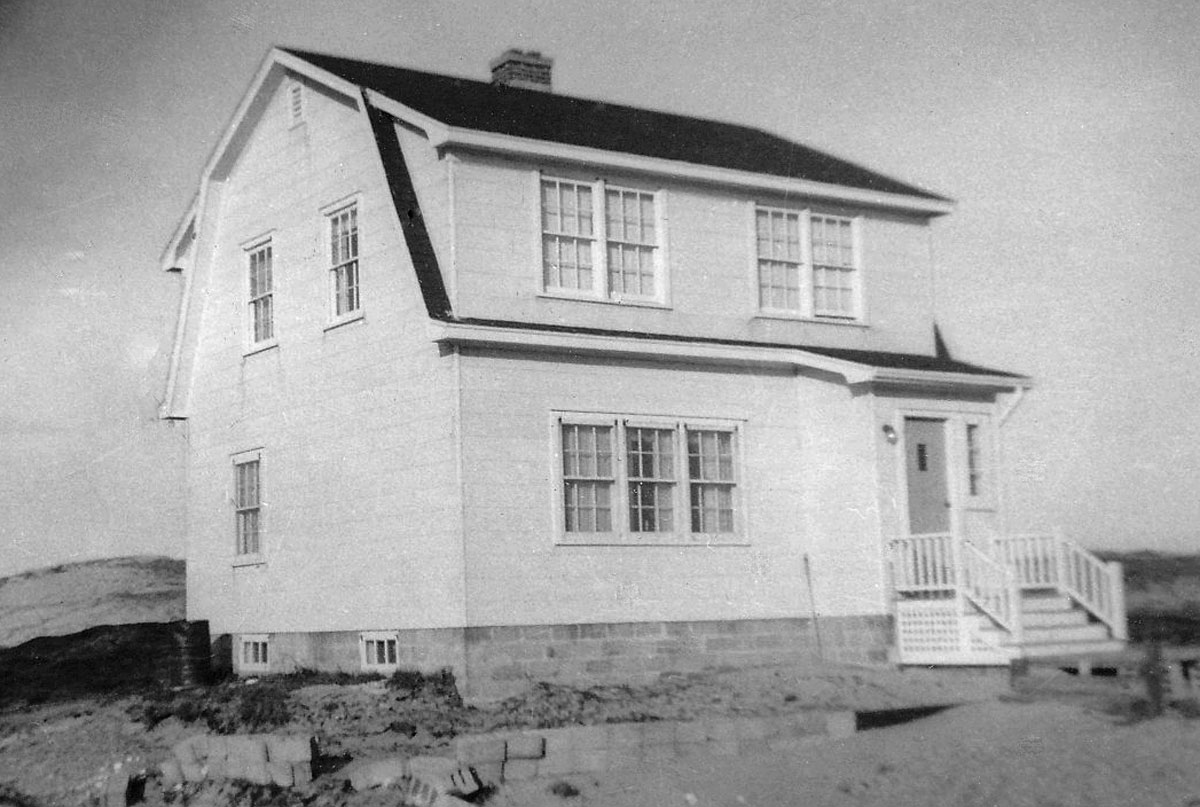 At the MSC station. In 1955-56, this was where MSC staff lived. It later became the OIC’s residence.
At the MSC station. In 1955-56, this was where MSC staff lived. It later became the OIC’s residence.
The OIC’s wife cooked for the MSC personnel, and staff went to the OIC’s house to eat their meals. Muriel was an excellent cook. Both Muriel and Ralph were very happy on the island. Evelyn was not as content to be there and so Max sometimes prepared the meals. In the spring of 1956 Max decided he could not cope with the stress of all the things he was responsible for, so he requested he be removed from the island. He sent a very persuasive message to Regional Office and they agreed he could leave. This was likely some time between May and August 1956. Since Max had indicated he could no longer do his shifts, the three other staff (myself and the two others) divided the work among ourselves. I don’t recall who replaced Max—his replacement may have arrived on the boat I left on in August.
The radio staff consisted of their OIC and two other men. Gerry Smith was in charge. Gerry’s wife Jean did the cooking for the radio operators. Gerry and Jean had two young children with them on the island. The other two radio operators, Leo Irvin and Wendell Burke, were single men. There was a one-story wooden building near the Superintendent’s house at West Light that was used as living quarters for the radio staff. Radio operations were housed in a Quonset building.
Charles Faulkner was the Superintendent of the island—in charge of everything. He lived in the house at the Main Station (the West Light area) and had a housekeeper. Vegetables such as potatoes and carrots were grown in a small garden near the Superintendent’s house. There were several Quonset buildings at the Main Station. One of the Quonset buildings was used for storage of items that were found on the beach. Some of these are now in the museum in Halifax. Other Quonset buildings were used as barns for the horses, and for temporary storage of items delivered by ship. Items delivered to the island needed to be stored temporarily in order to off-load the ship as quickly as possible. They were distributed to the other sites after the ship departed.
Faulkner was 65 years old and could have retired at 65, but he wanted to stay on for one more year. He died at 66, on April 28, 1956, in his house on Sable Island. He had angina, and although he had a puffer, he suffered an attack while he was downstairs, having left his puffer upstairs. It was foggy and the DOT helicopter could not come to pick up his body. The DOT vessel Edward Cornwallis was sent out, but in the meantime, one of the food freezers was emptied and Faulkner’s body was kept in it.
There were about 24 staffmen (“stevedores”) on the island. They were all young, single men. During the sealifts, the staffmen unloaded the supply boats—equipment and supplies came ashore from the ship in smaller boats and were loaded onto the wagon which was hauled by six horses (three pairs). Forty-five-gallon oil drums were dropped into the water from the vessel and floated ashore—the staffmen went along the beach gathering them up. Two drums in the wagon were as much as the team of horses could haul.
In addition to handling the cargo coming ashore, the staffmen looked after the East and West Lights. The rotating lights were floating in mercury and every day staff had to wind the mechanism that rotated the light. Since the East Light was some distance from the Main Station, they took turns staying at that site, rotating every two weeks or so. The men did their own cooking. They did all the general maintenance including taking care of a barn full of horses. They also picked cranberries to send back to mainland. (I built a large wooden box, filled it with cranberries, put my father’s name on it, and sent it to PEI express collect.)
Supply Ships
The sealifts were done by both the Lady Laurier and the Edward Cornwallis, and there were three ship operations annually—in spring, summer and fall. The food supplies for MSC were stored in the OIC’s house in freezers and storage rooms. To prevent rust, an oily rag was used to wipe all the canned goods before they were shelved.
MSC staff were expected to bring with them all personal needs that they would require for the four or five months between sealifts. For example, a person who smoked cigarettes would be expected to bring a supply that would do him until the next boat.
I had some help with this. Just before going to Sable Island, I met Rube Hornstein. Rube was the Officer-in-Charge of the Weather Office in Halifax. When I was asked to go to Sable, I had been in the service for only a few months, so I had not accumulated any leave credits. I asked Regional Office if I could take a couple of days to visit my parents in PEI, but was told I had no leave and that I was to report to Rube Hornstein’s office. When I arrived in Halifax and reported to Rube, I was told that the boat to Sable was delayed one week. I asked Rube if I could go to PEI for a couple of days, and not only did Rube give me the time to go, but he suggested he would take care of any needs I might have while on Sable Island. I left some money with him and Rube was kind enough to do some shopping for me and send it out on whatever transportation was going to the island.
Island staff could order whatever they wanted to have brought in on the ship—there were no restrictions regarding alcohol. I don’t recall any alcohol-related problems, except for a single incident. After bringing supplies off the ship, the staffmen would store them at West Light, and after the ship departed, the staffmen distributed the supplies. On one occasion the staffmen got drunk—perhaps enjoying a bottle or two that had come in on the ship—and there was a mix-up in the distribution of the food supplies. The MSC people did not receive their meat order. The staffmen insisted that they had delivered it, but eventually the meat was found misplaced under some other material—not in a freezer—and it was all bad. However, the MSC people had enough in storage that they did not go entirely without meat until the next ship.
The Met Service
There were two upper air (weather balloon) flights each day. The radio operators did the surface weather—they looked after communications. There was a telephone line between the MSC station and the radio operator’s building. MSC staff coded the upper air observations and called the numbers to the radio operator, and he sent the numbers on to Ketch Harbour Radio in Morse Code. (I’m not sure if it was Camperdown or Ketch Harbour, but it was probably Ketch Harbour because that is where radio operator Leo Irvin was posted to after leaving the island.)
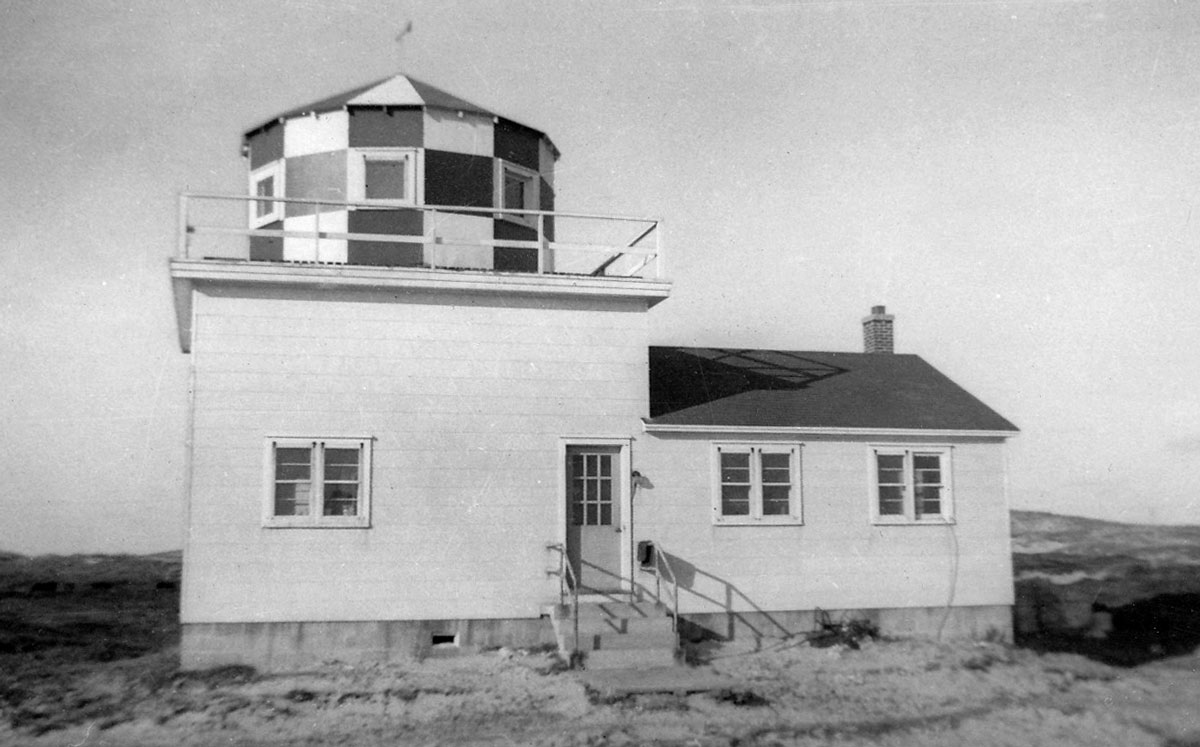 The MSC office. Inside the dome was an antenna used for tracking the radiosonde as it was carried aloft by the hydrogen-filled balloon. This provided wind data for each upper air flight.
The MSC office. Inside the dome was an antenna used for tracking the radiosonde as it was carried aloft by the hydrogen-filled balloon. This provided wind data for each upper air flight.
On one occasion when Bob and I were working together, Bob released the balloon and I tracked it. The balloon went to perhaps 90-100 thousand feet and circled back directly over the station. I was able to step outside the office and retrieve the instrument. Once, when a hurricane went through, one person filled the balloon and I released. I used a particularly short string between the balloon and the instrument, waited for a lull, and released. At the time they were using a small, tight latex balloon.
The hydrogen generator in use when I was on the island was a Gill Low-Pressure Generator. It used caustic soda, aluminum chips, and water to produce hydrogen gas. It generated enough to fill two balloons, but any more than that and the unit would become too hot to use. There was also a high-pressure hydrogen generator on site that could be used for second or third releases. However, since the MSC on staff on Sable never attempted more than two balloon releases, it wasn’t needed.
The high-pressure generator was a round cylinder about five feet long mounted on a stand so that it could be in a vertical position or could be tipped. It used the same chemicals as the low-pressure generator. With the unit on an angle of about 45-degrees, water was put into the cylinder. Then the other chemicals were added being careful they did not mix with the water. The cap was put on and the cylinder was turned to the vertical position causing the water to mix with the chemicals—very high pressure was created within the unit. A hose conveyed the hydrogen gas to the balloon. MSC staff were instructed in the use of this unit at the Upper Air Training School, but I never did use one.
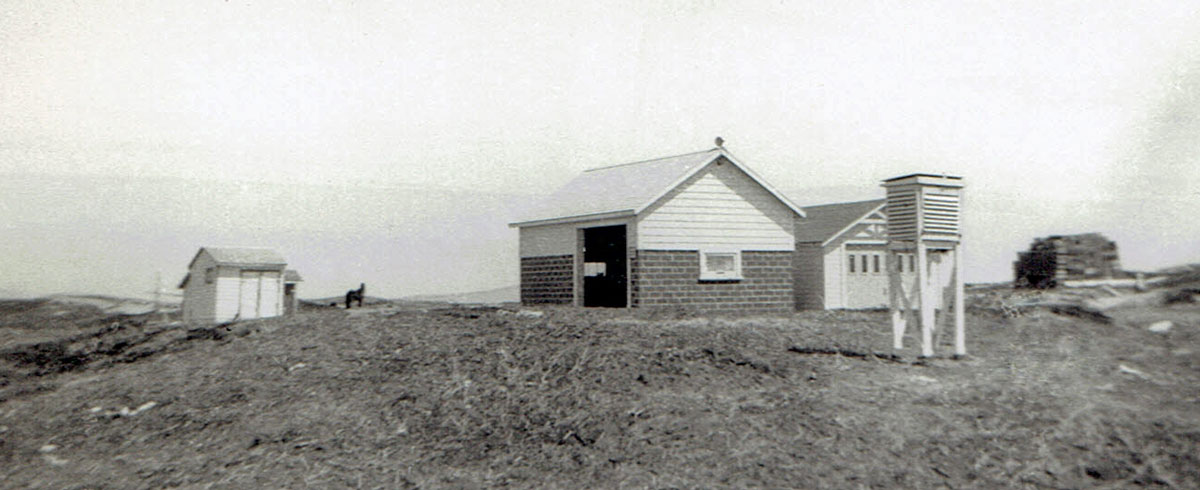 At the MSC station. The hydrogen shed (where the balloons were inflated), with the hen house to the left, and storage shed and Stevenson Screen to the right.
At the MSC station. The hydrogen shed (where the balloons were inflated), with the hen house to the left, and storage shed and Stevenson Screen to the right.
Reg Hody spent a lot of time on Sable Island. He was a very senior member of MSC—he was the original inspector as well as one of the senior managers in the Atlantic Region. Back then, the Atlantic Region included part of Quebec province. Forecasts were issued from the Dominion Public Weather Office in Halifax for Sept-Îles and for the Magdalen Islands.
Reg’s classification was Meteorological Officer which was a qualified meteorologist. He reported to the Regional Director. Reg was responsible for the capital budget in the region and was very much involved in improving the service. He would have been the one who approved the staff’s request for saddles and harness for the horses. The two rabbits were brought to the island sometime after I left, possibly during the years that Fred Androschuk was the OIC. The reason for the rabbit introduction is unclear, but Reg was always interested in improvements. The rabbit episode was the only one of Reg’s experiments that failed. Reg was shoveling his driveway one winter day in Moncton when he took a heart attack and passed away, probably around 1972 or 1973—he was still a young man.
Island Life
There were no motor vehicles on Sable Island during my time. MSC staff wanted to have a couple of horses. There were two horses near the station that could be captured and tamed, so the staffmen rounded them up, brought them to our station, and put them in the barn. They provided some hay and oats that MSC could use for the horses until we were able to bring in our own supply. The horses’ names were “Rawin” (radio winds) and “Raob” (radio obs). The MSC staff had no harness or saddles. I was brought up on a farm so I knew a little about horses. I got two metal bits and made two rope bridles (with long lengths of rope coiled). We rode the horses bareback, and were able to tame them fairly quickly. When we rode, we held onto the rope coils and if we were bucked off, we could hold onto the horses by the long ropes. The larger of the two horses, Raob, did most of the bucking and would often put his head down and turn sharply to the left or right. When saddles, harness, and a four-wheel wagon were delivered, the two horses were also used to pull the wagon.
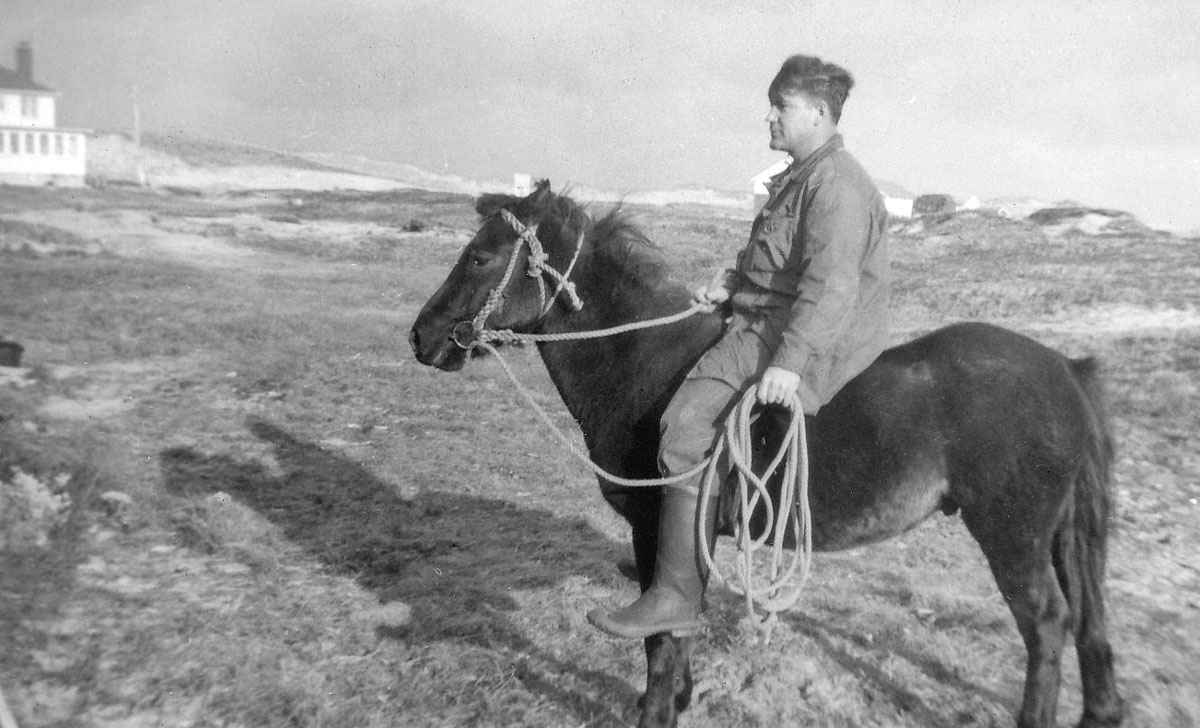 The MSC OIC, Max Lee, riding a Sable Island horse with handmade bridle and coil of rope.
The MSC OIC, Max Lee, riding a Sable Island horse with handmade bridle and coil of rope.
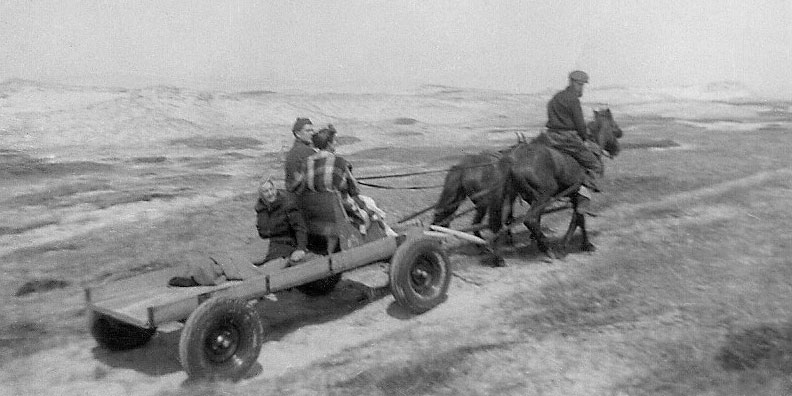 Max Lee and wife Evelyn together on the seat, and Evelyn’s mother sitting in the wagon. Jean-Guy Pagé is riding Roab, the larger of the two horses.
Max Lee and wife Evelyn together on the seat, and Evelyn’s mother sitting in the wagon. Jean-Guy Pagé is riding Roab, the larger of the two horses.
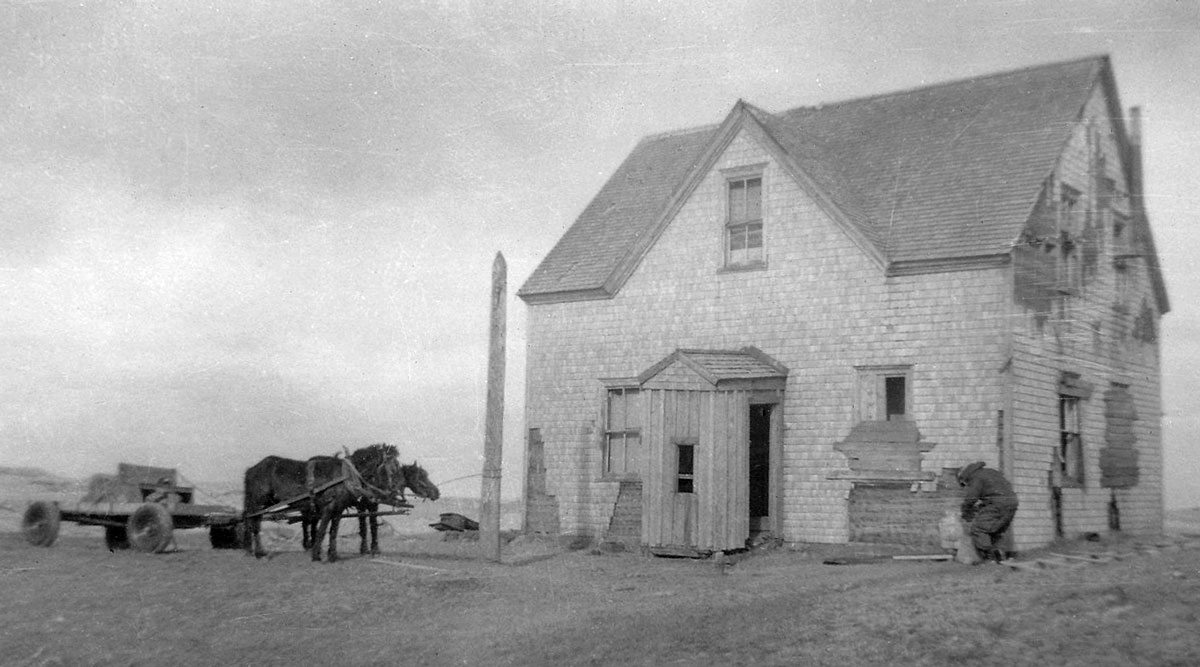 Roab and Rawin waiting with the wagon at the abandoned No.3 life-saving station house of the life-saving station.
Roab and Rawin waiting with the wagon at the abandoned No.3 life-saving station house of the life-saving station.
The water at the MSC station was not good quality. It came from sand points driven down into the freshwater table. There was a water pump in each house and in the office building (but not in the hydrogen shed or the barn). Although I had not seen it done, I understood that the sand points were driven to a depth of perhaps ten feet. The quality of water in the staffhouse was the best, in the OIC’s house next best, and in the office building it was the worst. I recall that the water was not clear, but drinkable. Sand may have been a good filter for salt but not for other materials in the water. We put some water in the refrigerator to let it settle and cool which helped. The refrigerator in the OIC’s house operated on kerosene oil.
There was a hen house near the hydrogen shed, so the MSC staff always had fresh eggs. The OIC looked after feeding them and gathering the eggs. Some of the kitchen waste was put out for the hens.
I don’t remember any cats or dogs on the island, and no trees were planted while I was there. I took my skates to Sable, but the ponds didn’t freeze during that winter. People swam in Lake Wallace in the spring, but in summer the lake water was warm and there were a lot of flies and more seals. I also swam off the north beach (never off the south beach) amongst the seals. At low tide, it was possible to walk from East Light to the east tip, a distance of six to eight miles. Bob Frank and I walked to East Light—we just wanted to see the other end of the island. The men staying at East Light invited us to stay the night, and we walked back the next day. MSC staff were always able to trade a shift—so the other two took our shifts, and we paid them back later.
Except for the Canso, an RCAF (Royal Canadian Air Force) amphibious aircraft, no fixed-wing aircraft landed on Sable while I was there. The Canso (which landed on Lake Wallace) was not normally used for resupply—used only for special occasions or emergencies. But the RCAF would occasionally fly out for practice, and sometimes the DOT Marine Agent could take advantage of the flight for transport of supplies or personnel. They always brought the mail.
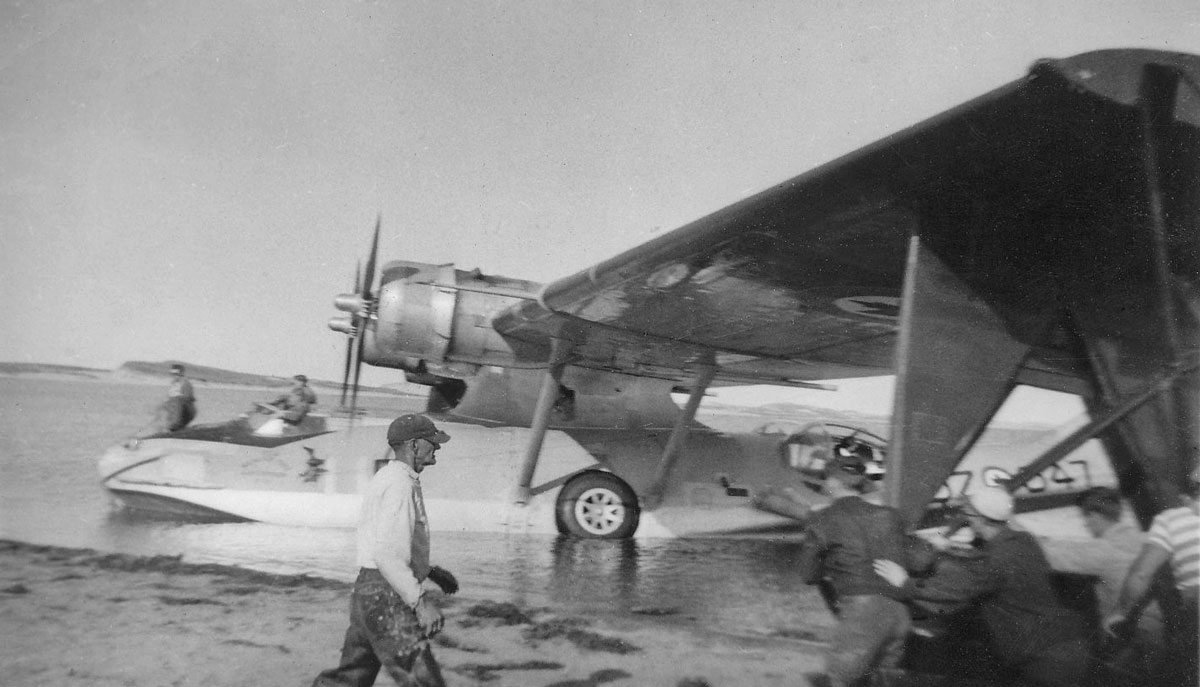 Island staff pushing the RCAF Canso around for boarding and takeoff. When the Canso landed on Lake Wallace, its tail section was turned to the shore so people could walk aboard without getting their feet wet. However, there were occasions when the beach was flooded and a boat was necessary to board the aircraft.
Island staff pushing the RCAF Canso around for boarding and takeoff. When the Canso landed on Lake Wallace, its tail section was turned to the shore so people could walk aboard without getting their feet wet. However, there were occasions when the beach was flooded and a boat was necessary to board the aircraft.
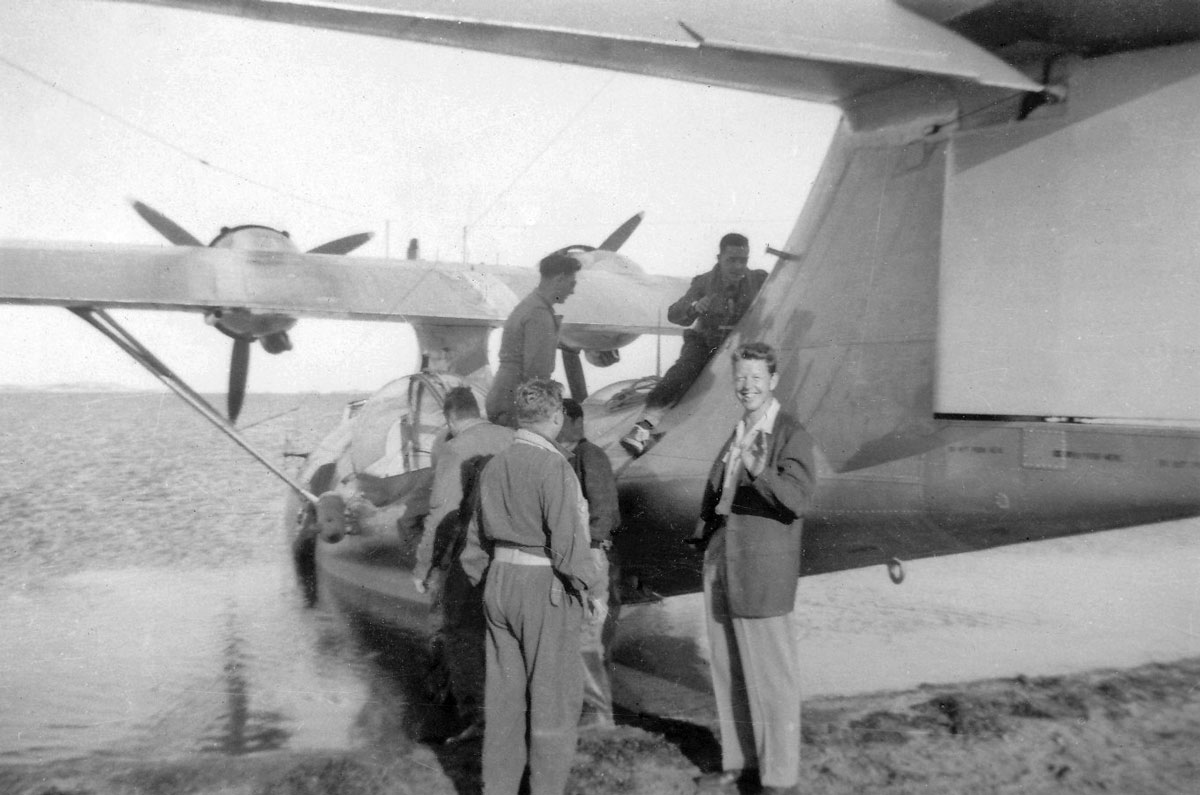 MSC’s Carl Wyman about to depart Sable Island on the Canso.
MSC’s Carl Wyman about to depart Sable Island on the Canso.
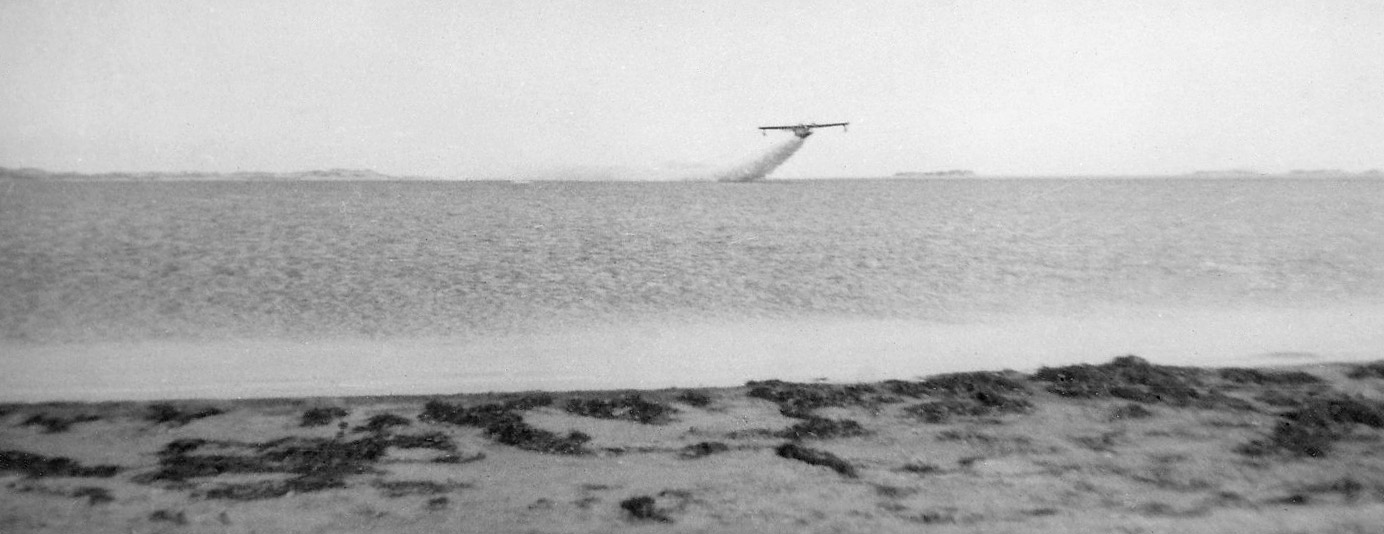 The Canso taking off from Lake Wallace. The aircraft was equipped with a JATO (jet assisted takeoff) to lift off the water. The thick plume is the emission from the JATO bottles which were like rockets. The assist probably wasn’t needed to take off from the lake, but it was an opportunity to practice.
The Canso taking off from Lake Wallace. The aircraft was equipped with a JATO (jet assisted takeoff) to lift off the water. The thick plume is the emission from the JATO bottles which were like rockets. The assist probably wasn’t needed to take off from the lake, but it was an opportunity to practice.
The lifesaving crew was not doing regular beach patrols during my time on the island, but, as mentioned above, materials and objects found on the beach were brought back and put in one of the Quonset buildings. Along the shoreline, parts of the wreckage of the Skidby (1905), Alfios (1946), and Manhasset (1947) were still visible.
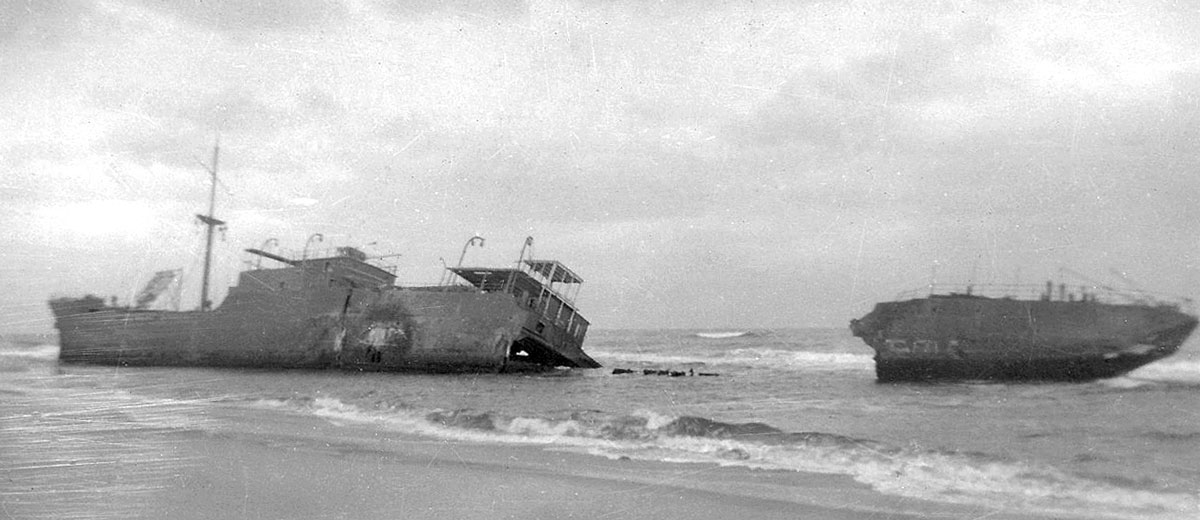 The Greek freighter Alfios wrecked in 1946 on the south side of Sable Island, near East Light.
The Greek freighter Alfios wrecked in 1946 on the south side of Sable Island, near East Light.
Two memorable events during my 15 months on Sable were an NFB crew that came to the island with Fred Davis in 1955, and the raft L’Égaré II that passed by the island. The raft crew called on the radio and Sable replied via the ham radio set-up. The raft crew could only speak French, so Jean-Guy talked with them and translated, forwarding their message to the mainland saying that they were OK.
I finally left Sable in August 1956 and was eligible to take holidays. I went to Bridgewater with Bob Frank for a couple of days, and then to PEI to visit my parents. In early September, after my holiday, I arrived at my next posting, the High Arctic weather station in Mould Bay, Prince Patrick Island, in an area of the Northwest Territories now known as Nunavut.
As told to Zoe Lucas by Merlin MacAulay
Prepared for the Sable Island Institute, December 2019
All photos provided by M. MacAulay
Notes (ZL):
a) After graduating with degree in meteorology from the University of Toronto in 1938, Rube Hornstein (1912-2003) joined the meteorological branch of the federal Department of Transport (DOT) and worked as an airport forecaster from 1938 to 1940. In March 1940, he was transferred to Halifax as Officer-in-Charge of the meteorological section of Eastern Air Command, administering meteorological services for the Canadian Armed Forces until 1946. For 26 years, from 1946 to 1972, he was Officer-in-Charge of the Halifax Atlantic Weather Centre, and reported weather for CBC Radio in Halifax. In 1954, Rube Hornstein began doing the weather forecasts for CBC’s television news program.
b) The National Film Board of Canada (NFB) produced a short documentary titled “Sable Island“, directed by Allan Wargon (28 minutes, black-and-white, 1956). In one scene, while host Fred Davis is exploring a freshwater pond area (eventually known as Lily Pond North), MSC’s Jean-Guy Pagé rides in and they have a chat about flowers, shipwrecks, and the life-saving service. The film provides an interesting and informative view of island life and activities, including the launch of an MSC upper air balloon, in 1955. In the latter, Gordon Miller is explaining the radiosonde, and Merlin MacAulay is doing the winds (seen above, next to the dome). Also, radio operator Wendell Burke is shown talking with Fred Davis.
c) In 1956 the raft L’Égaré II and its Canadian crew led by Henri Beaudout, crossed the North Atlantic—from Halifax, Nova Scotia to Falmouth, England—in 88 days.
For more information about the Meteorological Service (MSC) on Sable Island, see:
MSC’s Aerological Program Ends After 75 Years of Service
Full Circle, Gordon LeBlanc (1963-1964)
David Millar, a Personal History (1967-1969)
Clean-up of an Old Fuel Cache

